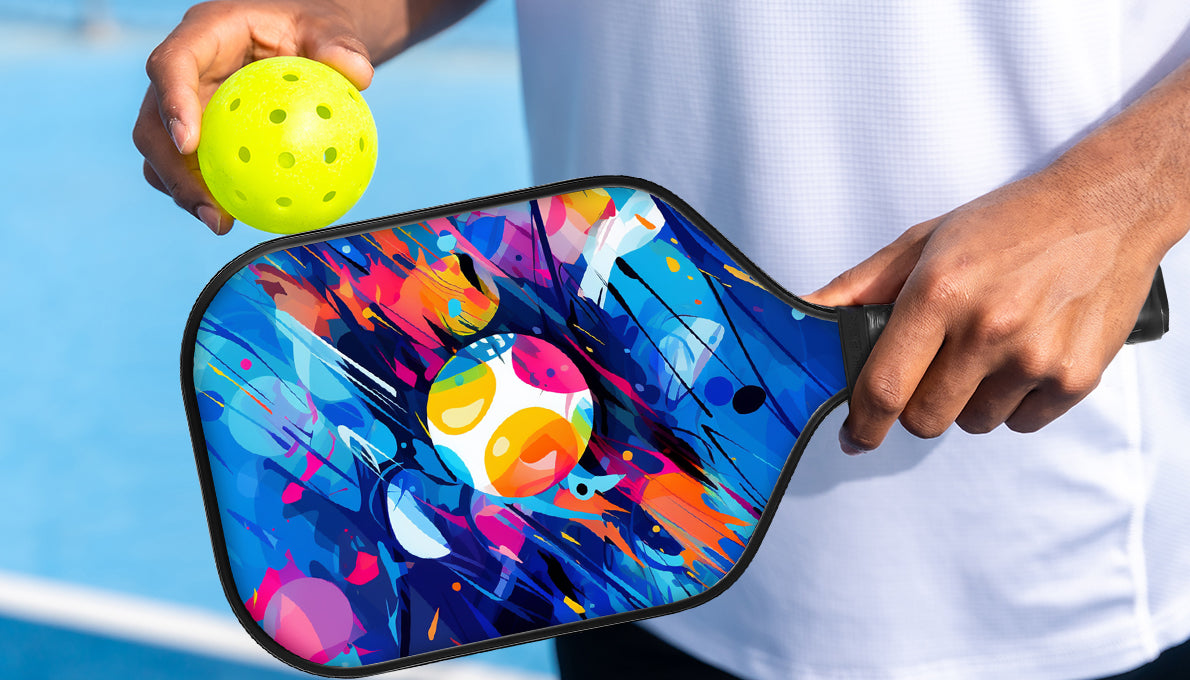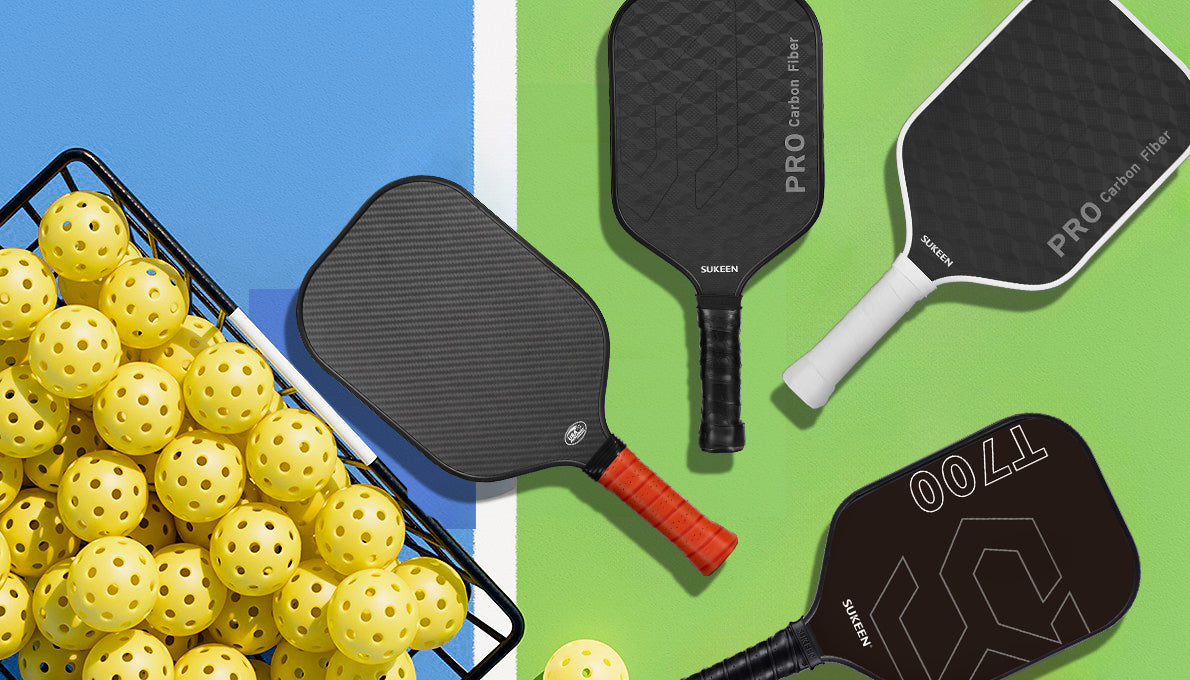How to Choose a Pickleball Paddle?
Ⅰ. Basic Components of a Pickleball PaddleⅡ. Tips for Choosing a Paddle
Ⅲ. Personal Experience and Recommendations
Ⅳ. Buying Advice
Ⅴ. Conclusion
As an outdoor enthusiast, you know that choosing the right equipment is essential to enjoying the outdoors. Pickleball is a unique sport that combines elements of tennis, table tennis, and badminton, and many people are drawn to it and eager to join the pickleball community. The key to getting started in this sport is choosing the right racket! The right racket affects the power and accuracy of your shots. It also greatly affects your comfort and enjoyment on the court, and helps minimize the risk of muscle fatigue or injury from using an inappropriate racket.
A pickleball paddle consists of several key parts, each contributing to its overall performance. Understanding these components can help you make an informed choice.
Ⅰ. Basic Components of a Pickleball Paddle
1. Paddle Face
a). Material Selection
The paddle come in a variety of face materials including wood, composite, carbon fiber and Kevlar. wood rackets are less expensive but heavier. Composite paddles are moderately heavy and cost effective, while carbon fiber paddles are the lightest and are suitable for professional players. Fiberglass paddles, commonly found in the low to mid-range market, are in between wood and composite, are moderately priced, and are lighter than wood paddles, but usually not as light as composite or carbon fiber paddles. There are also the more innovative Kevlar paddles, Kevlar is a high performance synthetic fiber commonly used in the construction of one of the higher end paddles. It is very lightweight and strong, making it easier to handle and more durable, but it is expensive and is usually used for high-level professional or competitive level paddles."What is the best material for a pickleball paddle?" introduces various materials in detail and introduces the best materials.
b). Size and Shape
The size and shape of the paddle face affect control and the sweet spot. Racket faces provide a larger hitting area, which helps to increase consistency and forgiveness, especially for beginners or players who need a larger hitting area. Smaller racket faces provide a more precise sense of control and are typically lighter than large , which helps with quick movement and quick reactions, but may be slightly less in terms of hitting area and forgiveness. Beginners may favor a large racket face for added stability, while advanced players may prefer a small racket face for greater control.In addition to the size of the racket, the size of the grip is also an important factor that affects performance. Please refer to "What is the Grip Size for a Pickleball Paddle?"
The most common shapes currently on the market are -- Elongated Shapes, Widebody Shape and Classic Shapes.
Elongated Shapes
6-7 inches wide and 17-24 inches long, many singles players prefer elongated racquets because they can cover more court and are especially useful when defending at the net.
Classic Shapes
A standard paddle is usually 7-8 inches wide and about 16 inches long. The hitting surface of a standard racquet has a larger sweet spot, which provides more room for mistakes and is more suitable for beginners.
Widebody Shape
8.25-8.75 inches wide and 15.5-16 inches long, providing a larger hitting area for players looking for more coverage or who need more forgiveness, but is heavier than the previous two.For more information about shapes, read "The Shape of the Pickleball Paddle".
c). Surface Texture
The texture of the paddle face can influence ball spin. Textured surfaces can provide more spin, adding an extra dimension to your game.The most common surface textures on the market today are Smooth, Honeycomb , and Rough/Sanded Surface. Players who need more control and spin may favor textured surfaces, while players who prefer quicker swings and reactions may prefer smooth or lightly textured surfaces, so the choice of surface texture for a racket face should take into account the individual's style of play and preferences.If you are interested in adding surface texture to your racket, you can read "How to Add Texture to the Pickleball Paddle?".
2. Grip
Paddle grip selection is also very important for experienced players and is based on grip length, size, material and style. Grip lengths typically range from 4 to 5 inches. Longer grips are suitable for players who use both hands or need more control; shorter grips offer better maneuverability for single-handed players. The grip circumference affects comfort and handling. Choose a grip size based on the size of your hand, usually available in small, medium, and large. Grips are usually made from synthetic leather or rubber, providing anti-slip features to ensure a secure hold during play.The choice of grip style usually depends on the individual's hand preference, gripping habits, and need for grip comfort, and common styles include,Straight Handle,Ergonomic Handle,Paddle with Thumb Control and Tapered Handle.In addition to the paddle grip, the use of the overgrip can extend the life of the grip. "How to clean and maintain pickleball paddle?" provides a detailed introduction on how to clean and replace it.
3. Edge Guard
Edge Guard protects the racket from damage when hitting the ball or hitting the ground, especially when catching lower positioned balls, without Edge Guard the racket would be susceptible to damage. It is usually made of plastic or rubber, which extends the life of the racket. Alternatively, some racquet designs feature a frameless construction for players who are looking for a lighter weight and larger hitting area, but may sacrifice some edge protection. Most players will opt for plastic edges with good protection and durability, while soft rubber edges are suitable for those concerned with feel and shock absorption.There are many types of edge protection, and "A Guide to Pickleball Paddle Edge Guard Types" will take you to know them.
4. Weight
a). Impact of Weight on Play
The weight of the paddle directly affects the speed and control of your shots. Lighter paddles are ideal for quick reactions and agility; heavier paddles offer more power and stability.
b). Weight Categories
Light Paddles (7-7.5 oz)
Suitable for beginners and players with less wrist strength.
Medium Paddles (7.5-8.5 oz)
Suitable for most players, balancing power and control.
Heavy Paddles (8.5+ oz)
Suitable for power players, providing stronger hits.
c). Balancing Weight and Comfort
It's crucial to find a balance between paddle weight and comfort. A paddle that's too heavy can cause fatigue and strain, while a paddle that's too light may lack power.How to choose the right paddle weight for you is especially important, and reading "What Pickleball Paddle Weight is Right for Me?" will definitely help you.
5. Core material and structure
The core construction of a Pickleball racket has a significant impact on the performance, weight and feel of the racket.In order to choose the right Pickleball racket, it is important to understand the different types of cores available. The most common are Polymer Core, Aluminum Core and Nomex Core.They all have one thing in common, they are all honeycomb construction. This is because honeycomb construction is lightweight, has good durability and rigidity, and provides excellent shock absorption. Different materials of honeycomb construction have their own specific advantages and application scenarios. Choosing the right core construction for you can be based on your individual playing style, skill level and specific needs of your racket.The material and structure of the racket will affect the thickness of the racket. "Pickleball Paddle Choice Between Different Thicknesses" introduces the impact of different thicknesses.
Ⅱ. Tips for Choosing a Paddle
Among the many types of paddles, we can provide you with the following tips to help you choose the paddle that is more suitable for you.
The choice can be based on your preferred hitting options, physical condition, preferred brand, and budget.
1. Choosing Based on Play Style
a). Offensive vs. Defensive
Based on different playing styles: There are two types of playing styles, offensive and defensive, and the strategies used for different playing styles are different. Whether it's weight, length, thickness, material selection, or grip, there will be very different choices, and the wrong choice of paddle will seriously affect the sports experience. Taking weight as an example, offensive players usually need power and speed, so light to medium weight paddles are ideal; defensive players focus on control and stability, so medium to heavy weight paddles are more suitable.If you are also interested in rackets that produce more spin balls, you can read "Master the Secret of Spin Ball".
b). Choosing Based on Physical Condition
Based on different physical conditions: consider the health of your shoulders, wrists, and elbows when choosing a paddle. Elderly people, those with a history of injuries, weaker muscles, and beginners should pay special attention to weight and grip comfort when choosing a paddle. Look for paddles with ergonomic grips and balanced weight distribution to minimize stress and increase comfort.
c). Brand and Budget
If you still can't make a choice after going through the above methods and having trouble choosing, you can try choosing high-quality paddles from well-known brands, each of which has its unique features and technologies that cater to the needs of different players. Some of the well-known brands are: Paddletek, Selkirk, and Onix. However, one drawback is that they are more expensive. So if you have a limited budget, but want to choose a more cost-effective and more suitable racket, then you must not miss the paddle of SUKEEN! If your budget is within $100 , you can refer to "Best Pickleball Paddle under $100" to choose the racket you like.
Ⅲ. Personal Experience and Recommendations
As a pickleball enthusiast, I have tried various paddles. Here are some of my top recommendations based on personal experience:
1. Paddletek Bantam EX-L
This paddle is ideal for beginners and intermediate players. It offers a balanced weight and comfortable grip, making it suitable for most players. The composite face provides a good mix of power and control.
2. Selkirk AMPED S2
For advanced players, the Selkirk AMPED S2 is a fantastic choice. Its lightweight design and high-quality materials make it perfect for quick shots and agility. The paddle's larger face also offers a substantial sweet spot.
3. Onix Graphite Z5
This paddle is known for its excellent ball control and touch. It's lightweight, making it easy to maneuver, and the graphite face provides a great feel for the ball.

Ⅳ. Buying Advice
When buying a pickleball paddle, consider the following aspects to make an informed decision:
1. Online vs. In-Store Shopping
a). Online Shopping
The choice of buying online or offline is based on one's shopping habits. As we all know, online shopping has more choices and is very convenient. Before buying a paddle online, carefully read the product description of the racket and user reviews, which usually provide practical experience and suggestions. Next, compare prices and possible promotions on different websites to get the best purchase price. It is especially worthwhile to check the website's return policy to ensure that you are able to make a return or exchange process if necessary to deal with a possible failure to meet expectations or damage.
b). In-Store Shopping
If you prefer to buy offline, you can go to a physical store to feel the weight and grip comfort of the paddle. You can look for a professional sporting goods store or pickleball club that has a good selection in advance before shopping offline. Brick-and-mortar stores are usually staffed by professional salespeople, so talk to them and ask for some help. It's also important to be aware of return policies and warranties. Before deciding to buy, check online reviews and compare different brands and models to help you understand how the paddle performs and what other users have experienced. Choose brands and sellers that offer good after-sales service and warranties for better protection and service after purchase. A good warranty can save you. Warranty situation be careful to check the duration of the warranty, understand what the warranty covers (e.g., manufacturing defects, material issues) and ensure the process for claiming warranty service is straightforward.
2. Second-Hand Paddle Purchase Tips
If you are on a very limited budget, there is another way to get the right paddle, and buying a used paddle is a super practical way to do it. First of all, choose a trusted used paddle sales channel or platform, such as eBay, Craigslist, Facebook Marketplace, etc., which offers a large selection of used paddles. Some sporting goods stores or used sports equipment stores also sell used paddles, so you can check the condition of the paddles in person. Before making a deal, pay special attention to the paddle's face and grip section for cracks, dents, or blistering of the material, as any such damage can seriously affect its use. Secondly, find out more about the paddle's usage history and frequency from the seller in order to assess its remaining useful life. Find out the market price before buying and negotiate a reasonable price with the seller based on the actual situation.
Ⅴ. Conclusion
Overall, choosing the ideal pickleball paddle is extremely important to improving your personal skills and experience of the sport. After explaining the various parts of a paddle and providing selection tips, I am sure you will find the paddle that best suits your needs. I sincerely hope to help you make an informed decision and improve your experience with pickleball!
Related Articles
What to Look for in a Pickleball Paddle?What Pickleball Paddle Weight is Right for Me?
How to Play Pickleball?
Mastering Pickleball with Lead Tape
Master the Secret of Spin Ball






